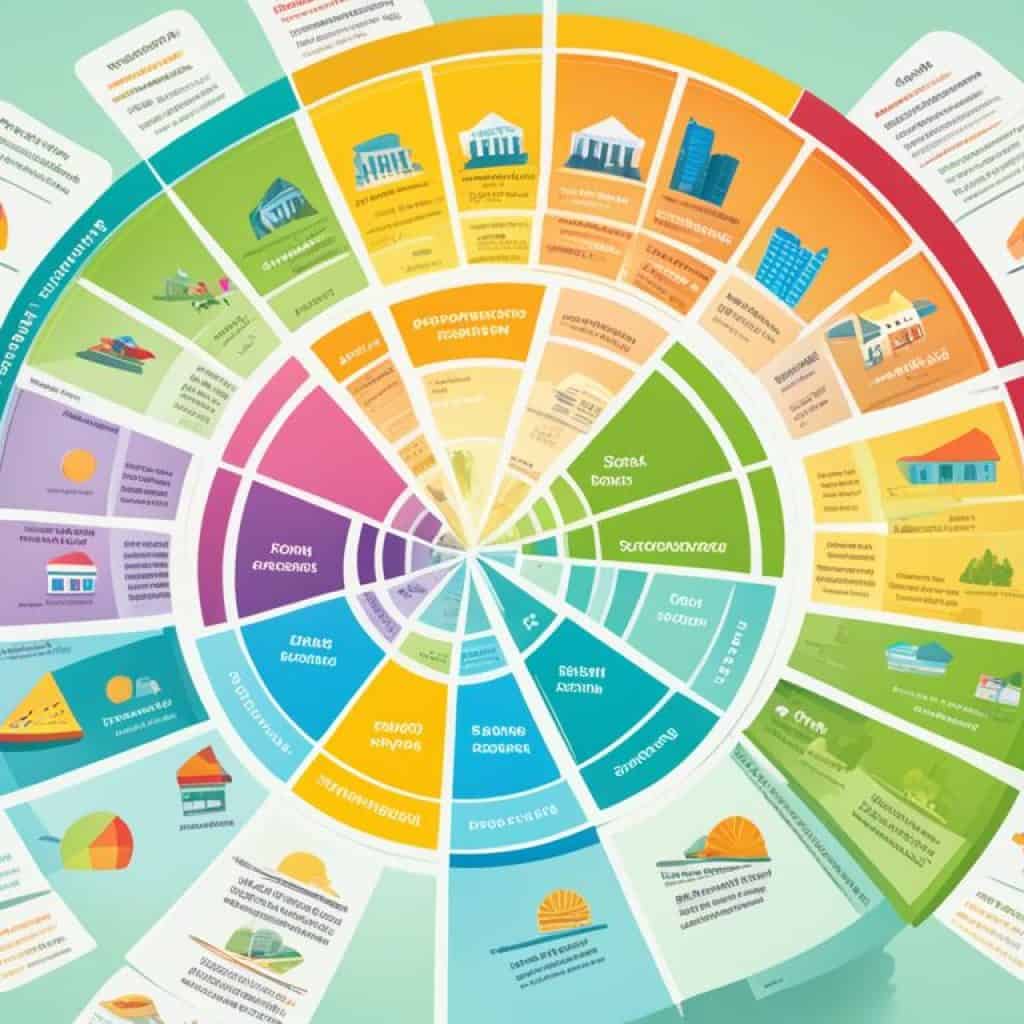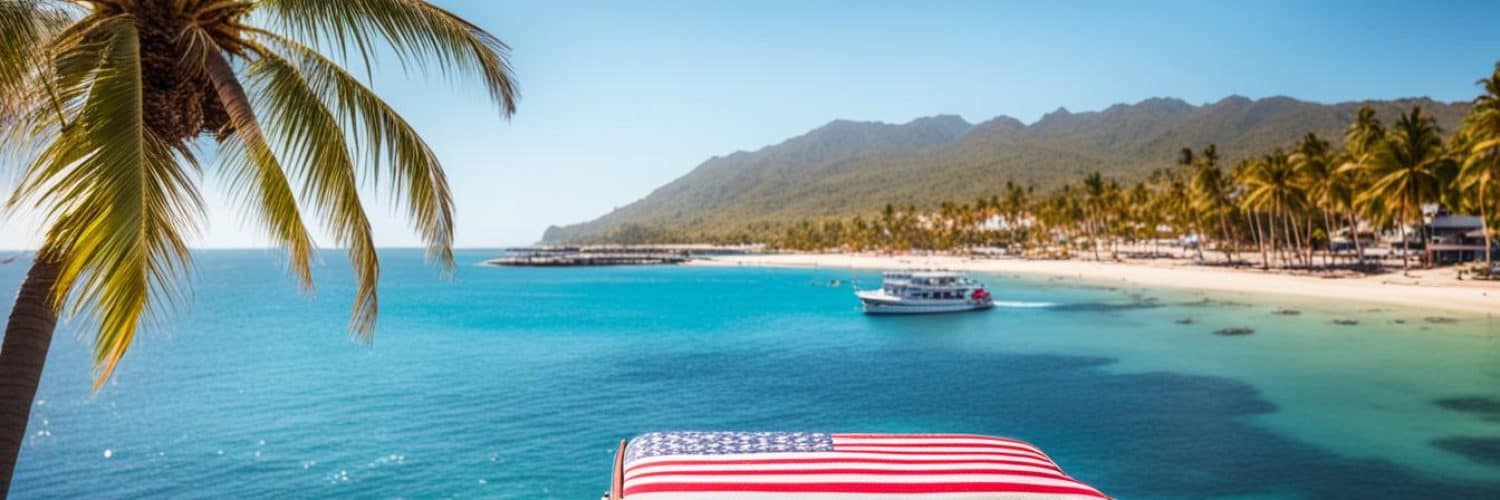Are you an American dreaming of moving to the Philippines? Curious about what it takes to relocate from the US to this beautiful Southeast Asian country? Well, get ready for an exciting adventure! Whether you’re considering a change of scenery for work, retirement, or simply seeking a new cultural experience, this ultimate guide is designed to provide you with all the necessary information you need to make your relocation smooth and exciting. From visas and cost of living to housing, healthcare, and managing your finances, we’ve got you covered. So, are you ready to embark on this exhilarating journey?
Key Takeaways:
- Learn about the different visa options available for Americans moving to the Philippines.
- Discover key facts about the Philippines, such as its capital, languages spoken, and population.
- Understand the basics of daily life in the Philippines, including cost of living, healthcare, education, and transportation.
- Get insights into finding housing in the Philippines and navigating the banking and taxation systems.
- Learn about Wise as a helpful resource for managing your finances during your relocation.
Key Facts About the Philippines
As an American moving to the Philippines, it’s important to familiarize yourself with key facts about the country to better understand its culture and way of life. Here are some essential details:
- The capital of the Philippines is Manila.
- The main languages spoken in the country are Filipino and English.
- The population of the Philippines is approximately 117 million.
- The currency used in the country is the Philippine peso (PHP).
- The government of the Philippines follows a democratic and presidential representative federal republic system.
- The predominant religion in the Philippines is Christianity.
These key facts will provide you with a foundation of knowledge as you plan your move and allow you to navigate the country more confidently and effectively. Embrace the diversity and richness of the Philippines during your relocation as an American expat.
“The Philippines is a captivating country with a vibrant culture and warm, welcoming people. By understanding its key facts, you can fully immerse yourself in its beauty and make the most of your American to Filipino transition.” – [Your Name]
Can US Citizens Live in the Philippines?
US citizens have the opportunity to legally move to the Philippines for a long-term stay. Whether you are considering a move for work, study, retirement, family reasons, or marriage, there are different visa options available to suit your specific circumstances. It is crucial to choose the right visa and ensure that you meet all the necessary requirements for your intended stay.
Living in the Philippines as an American citizen can be an exciting and rewarding experience. The country offers a vibrant culture, beautiful landscapes, and warm hospitality. However, it’s important to navigate the legal requirements and visa process to ensure a smooth transition.
There are various visa options available for US citizens planning to live in the Philippines:
- Non-Immigrant Visas: These visas are suitable for individuals planning to work, study, or engage in certain activities in the Philippines. The specific visa categories include work visas, student visas, and specific-purpose visas.
- Immigrant Visas: These visas are available for those who wish to permanently reside in the Philippines. They are typically granted based on family reunion, employment, or retirement.
- Special Visas: The Special Resident Retiree’s Visa (SRRV) is a unique visa option for retirees who want to live in the Philippines. It offers various benefits and advantages.
Each visa category has its own requirements and application process. It is crucial to research and understand the specific details and eligibility criteria for the visa you are interested in. Consult the Philippine Embassy or Consulate in your home country for updated and accurate information.
Visa Requirements for US Citizens Moving to the Philippines:
The specific requirements for each visa category may vary, but common requirements include:
- Passport with at least six months validity
- Completed visa application form
- Proof of financial capability
- Medical certificate
- Police clearance or background check
- Supporting documents specific to the visa category
It is advisable to start the visa application process well in advance of your planned move to allow for any processing delays or additional requirements. Working with an immigration attorney or consultant who specializes in Philippine visas can also provide valuable guidance and support throughout the process.
“Moving to the Philippines as a US citizen offers exciting opportunities for adventure and personal growth. By understanding the visa options available and fulfilling the necessary requirements, you can embark on this new chapter of your life with confidence and excitement.”
| Visa Category | Requirements |
|---|---|
| Non-Immigrant Visas |
|
| Immigrant Visas |
|
| Special Resident Retiree’s Visa (SRRV) |
|
Immigration and Visas for Americans Moving to the Philippines
When it comes to moving to the Philippines as a US citizen, there are various visa options available to suit your specific circumstances. Whether you’re planning to work, study, retire, or join family in the Philippines, it’s essential to understand the different visa types and their requirements.
Work Visas
If you’re moving to the Philippines for employment, you’ll need to apply for a work visa. The most common types of work visas include the 9(g) Pre-Arranged Employment Visa and the Special Work Permit. These visas require sponsorship from a Filipino employer and have certain eligibility criteria that must be met.
Student Visas
If you’re a student planning to pursue your education in the Philippines, you’ll need to obtain a student visa. This visa allows you to stay in the country for the duration of your study program. To apply for a student visa, you’ll need to provide proof of acceptance from a Philippine educational institution and meet other specific requirements.
Retirement Visas
If you’re a retiree looking to spend your golden years in the Philippines, you can apply for a retirement visa. The most popular retirement visa is the Special Resident Retiree’s Visa (SRRV), which offers various benefits and privileges to foreign retirees. To qualify for an SRRV, you’ll need to meet certain age and financial requirements.
Spouse Visas
If you’re married to a Filipino citizen or a permanent resident of the Philippines, you can apply for a spouse visa. This visa allows you to join your spouse in the Philippines and stay for an extended period. The application process involves providing proof of your marital relationship and meeting other requirements.
Other Visa Types
There are additional visa types available for specific situations, such as the Special Investor’s Resident Visa (SIRV) for foreign investors, the Special Non-Immigrant Visa (SNIV) for individuals with unique skills or talents, and the quota visas for individuals who are engaged in specific professions or industries. Each visa type has its own set of requirements and application procedures.
To ensure a smooth relocation to the Philippines, it’s important to research and understand the visa requirements for your specific situation. Consult with the appropriate Philippine embassy or consulate in your home country to gather accurate and up-to-date information regarding the visa application process.

With the right visa in hand, you’ll be ready to embark on your new adventure in the Philippines. The next section will dive into the basics of living in the Philippines, including the cost of living, housing options, healthcare, and more.
Living in the Philippines: The Basics
Moving to a new country can require a period of adjustment. Living in the Philippines offers a unique experience with its diverse culture, affordable cost of living, and a wide range of options for housing. Understanding the basics of daily life, such as the cost of living, healthcare, banking, taxation, education, and transportation, will help you adapt more easily.
Cost of Living
The cost of living in the Philippines is generally lower compared to the United States. Daily expenses such as meals, groceries, transportation, and rent are significantly cheaper. For example, a three-course meal for two people can cost as low as $21.52, and the monthly rent for a 1-bedroom apartment in the city center is around $324.40. Understanding the cost of living will help you budget and plan your finances accordingly.
Healthcare
The healthcare system in the Philippines consists of both public and private healthcare facilities. While the public healthcare system has its limitations, private healthcare offers higher quality services and facilities. Expats are encouraged to secure private health insurance to ensure access to the best healthcare facilities. It is important to research and choose the right insurance coverage before moving to the Philippines.
Banking and Taxation
Opening a bank account in the Philippines as a US citizen is possible, and you can expect to find most banking services in major cities. It is recommended to visit a branch in person to complete the necessary documentation and verification. ATMs are widely available in cities, but fees may apply. Familiarize yourself with the banking system and taxation regulations to manage your finances effectively.
Education
The education system in the Philippines follows an American model and is based on English and Filipino as the languages of instruction. There are a mix of public and private schools, along with international schools catering to expat children. The school year generally runs from June to March. Researching and choosing the right school for your children is crucial when relocating to the Philippines.
Transportation
Navigating the Philippines can be challenging due to its thousands of islands. In major cities like Manila, there are various modes of transportation available, including buses, jeepneys (converted US military jeeps), tricycle taxis, and taxis. Domestic flights and ferries are common methods of travel between islands. It is important to plan your transportation options in advance and be aware of local customs and regulations.
| Aspect | Details |
|---|---|
| Cost of Living | The cost of living in the Philippines is generally lower compared to the United States. Daily expenses such as meals, groceries, transportation, and rent are significantly cheaper. |
| Healthcare | The healthcare system in the Philippines consists of both public and private healthcare facilities. Expats are encouraged to secure private health insurance. |
| Banking and Taxation | Opening a bank account in the Philippines as a US citizen is possible. Familiarize yourself with the banking system and taxation regulations to manage your finances effectively. |
| Education | The education system in the Philippines follows an American model and is based on English and Filipino as the languages of instruction. |
| Transportation | In major cities like Manila, there are various modes of transportation available, including buses, jeepneys, tricycle taxis, and taxis. |
Cost of Living in the Philippines
When it comes to the cost of living, moving to the Philippines as an American offers significant savings compared to the United States. From daily expenses to housing, you’ll find that everything is generally more affordable, allowing you to stretch your budget further and enjoy a comfortable lifestyle. Let’s take a closer look at some of the key aspects of the cost of living in the Philippines.
1. Meals and Groceries
The cost of food in the Philippines is considerably lower than in the United States. Whether you dine out or cook at home, you can enjoy delicious meals at a fraction of the price. A three-course meal for two people in a mid-range restaurant can cost as low as $21.52, and groceries for a week typically amount to about $50 per person.
2. Transportation
Transportation expenses in the Philippines are also much more affordable compared to the United States. Public transportation options, such as buses and jeepneys, are inexpensive and widely available. The average monthly cost of transportation in the Philippines is around $35 to $70, depending on your location and travel preferences.
3. Rent and Housing
Renting a place to live in the Philippines is significantly cheaper compared to the United States. The monthly rent for a 1-bedroom apartment in the city center is around $324.40, while the same apartment outside the city center can cost as low as $203.30. If you’re looking for more space, a 3-bedroom apartment in the city center can range from $648 to $1,296 per month.
4. Utilities
The cost of utilities, including electricity, water, and internet, is relatively affordable in the Philippines. On average, monthly utility bills for a standard apartment can range between $70 to $110. Keep in mind that usage, location, and lifestyle can affect the actual costs.
5. Healthcare
Healthcare costs in the Philippines are generally lower compared to the United States. Quality healthcare services and medications can be obtained at a fraction of the price. It’s advisable to secure health insurance to ensure comprehensive coverage and access to private healthcare facilities, which may cost around $60 to $100 per month.
Overall, the cost of living in the Philippines allows you to enjoy a comfortable and fulfilling lifestyle without breaking the bank. By understanding and planning for the lower expenses, you can budget your finances accordingly and make the most of your move overseas.
Here’s a table summarizing the cost of living in the Philippines:
Cost of Moving to the Philippines
Before you can settle in the Philippines, it’s important to consider the cost of moving your belongings from America. This includes shipping costs, flights, and potentially bringing your pets along. Planning ahead and getting quotes from shipping companies will help you budget for this expense.
| Cost Item | Estimated Cost Range |
|---|---|
| Shipping a full container | $850 – $4,500 |
| Flights | Varies depending on airline and season |
| Bringing pets | Varies depending on pet size and airline regulations |
Shipping a full container from the US to the Philippines can cost anywhere between $850 and $4,500. The actual cost will depend on the size of the container and the shipping company you choose.
If you plan on bringing your pets with you, be sure to check airline regulations and additional fees. The cost will vary depending on the size of your pets and the specific requirements of the airline.

By considering the cost of moving your belongings, you can budget accordingly and ensure a smooth transition to your new home in the Philippines.
Housing in the Philippines
Rental options are popular among new arrivals, as they allow you to explore different areas and neighborhoods before making a long-term commitment. This flexibility enables you to settle down in the Philippines as an American in a location that best suits your needs and preferences.
When searching for housing, it is essential to consider factors such as location, amenities, and transportation accessibility. Carefully assess the proximity to essential services like schools, healthcare facilities, and shopping centers. Additionally, consider the availability of public transportation and the convenience it offers for your daily commute and getting around.
Here are a few important points to keep in mind when looking for housing in the Philippines:
- Research the different neighborhoods and areas to understand which ones align with your lifestyle and requirements.
- Check if the property has the amenities and features that are important to you, such as parking, a gym, or a swimming pool.
- Consider the security measures and safety of the area, especially if you are relocating with your family.
- Understand the terms and conditions of the lease agreement or purchase contract, including the duration, rent or purchase price, and any additional fees.
“Finding a comfortable and suitable home is crucial for settling down in the Philippines as an American. Take the time to research and visit potential properties to ensure they meet your needs. Embrace the unique experience of discovering the different neighborhoods and enjoy the adventure of finding your new place to call home.”
By considering these factors and conducting thorough research, you can find a housing option that aligns with your needs and preferences, making your transition to life in the Philippines as an American even more enjoyable.
Healthcare in the Philippines
The healthcare system in the Philippines offers both public and private healthcare facilities to cater to the needs of its residents. While the public healthcare system may have its limitations, private healthcare providers offer higher quality services and facilities. For American expats moving to the Philippines, it is strongly recommended to secure private health insurance to ensure access to the best healthcare facilities and services.
Researching and choosing the right health insurance coverage is crucial before your move. Having private health insurance will give you peace of mind, knowing that you have access to comprehensive medical care and facilities tailored to your needs.
Advantages of Private Healthcare in the Philippines:
- Access to top-quality medical facilities and equipment
- Shorter waiting times for consultations, tests, and procedures
- English-speaking healthcare professionals
- Wide range of specialized services and treatments
“Having private health insurance in the Philippines allows you to receive the best medical care and ensure your well-being as an American expat. Choose a reputable insurance provider that offers coverage tailored to your needs and budget.”
Recommended Insurance Providers
Banking and Taxation in the Philippines
When you’re an American moving to the Philippines, managing your money effectively is crucial. Opening a bank account in the Philippines as a US citizen is a straightforward process, with most major cities offering a wide range of banking services.
It is highly recommended to visit a branch in person to complete the necessary documentation and verification. This not only ensures a smooth account setup but also allows you to establish a personal connection with the bank staff who can provide assistance and guidance tailored to your specific needs.
Once you have your bank account set up, you will have access to a variety of services, including online banking, ATMs, and money transfer options. ATMs are widely available in cities; however, it’s important to note that fees may apply for certain transactions or withdrawals. Familiarize yourself with the banking system and the fees associated with different services to make informed decisions about your financial transactions in the Philippines.
Furthermore, it’s essential to understand the taxation regulations in the Philippines. As an American expat in the Philippines, you may still have tax obligations to the United States. It is advisable to consult with a qualified tax professional who specializes in international taxation to ensure compliance with both US and Philippine tax laws.
By managing your money wisely and understanding the banking system and taxation regulations, you can navigate your financial matters smoothly during your transition to the Philippines.
| Banking Services in the Philippines | Taxation Regulations |
|---|---|
|
|
Image:

Education in the Philippines
The education system in the Philippines follows an American model, with English and Filipino as the languages of instruction. Whether you are considering public, private, or international schools, there are various options available to cater to the needs of expat children. It is essential to research and choose the right educational institution for your children when relocating to the Philippines.
Here are some key points to consider:
- The school year in the Philippines generally runs from June to March.
- Public schools offer free education but may have limited resources and facilities.
- Private schools often provide a higher quality of education and offer a wider range of extracurricular activities.
- International schools follow international curricula and are ideal for expat children, providing continuity in their education.
Research and visit prospective schools to better understand their teaching methods, curriculum, academic track record, and extracurricular opportunities. Consider factors such as location, transportation, accreditation, and the availability of special education programs if your child requires them.
Getting Around in the Philippines
“The Philippines is a country with a unique transportation system, offering various modes of transport for locals and tourists alike. From colorful jeepneys to tricycle taxis, you’ll find a range of options to choose from.”
One of the most iconic modes of transportation in the Philippines is the jeepney. These vibrant vehicles, originally adapted from US military jeeps, are a common sight on the streets and offer an affordable way to travel short distances within the city.
Another popular option for getting around in the Philippines is the tricycle taxi. These are motorbikes or motorcycles with sidecars that can accommodate a few passengers. They are a convenient way to travel within neighborhoods or to nearby destinations.
If you prefer a more comfortable and private ride, taxis are readily available in major cities. Just make sure to use reputable taxi services or ride-hailing apps to ensure your safety and avoid scams.
For longer distances or inter-island travel, domestic flights and ferries are the most common methods of transportation. Domestic airlines offer flights to various destinations within the Philippines, making it easier to explore different islands. Ferries are also a popular choice, especially in areas where islands are connected by water.
When traveling around the Philippines, it’s important to plan your transportation options in advance. Research the routes, schedules, and fares to ensure a smooth journey. Also, familiarize yourself with local customs and regulations to respect the cultural norms of the country.
The Benefits of Exploring by Public Transportation
While hiring private vehicles or using ride-hailing apps may seem convenient, opting for public transportation when possible can have its own advantages. Here are a few benefits:
- Cost-effectiveness: Public transportation is often more affordable compared to private options, allowing you to save money while exploring the country.
- Authentic experiences: Traveling by public transportation exposes you to the local culture and allows you to interact with fellow passengers, giving you a genuine taste of the Philippines.
- Eco-friendly: Using public transportation helps reduce your carbon footprint and contribute to a more sustainable way of traveling.
By utilizing different modes of transportation and exploring the Philippines like a local, you’ll not only get to your destination but also have a more immersive and memorable experience.
Save on Relocation Costs and Payments with Wise
When moving to the Philippines as an American, managing your finances during your relocation is essential. That’s where Wise (formerly known as TransferWise) comes in. Wise offers a convenient and low-cost solution that can help you save on relocation costs and streamline your payments.
By using Wise, you can cut the costs of international money transfers and hold multiple currencies in one account. This allows you to easily manage your finances and make payments in Philippine peso from the moment you arrive in the Philippines.
With Wise, you’ll benefit from:
- No hidden fees: Wise provides transparent pricing, so you know exactly what you’re paying for.
- Real exchange rates: You’ll get the real mid-market exchange rate, without any markups.
- Fast and secure transfers: Move your money quickly and securely, with peace of mind.
- Multi-currency account: Hold and manage money in multiple currencies, including US dollars and Philippine pesos.
- Local bank details: Get local bank account details for select currencies, making it easier to receive payments.
âWise offers a convenient and low-cost solution for managing your finances during your relocation to the Philippines. By using Wise, you can cut the costs of international money transfers and hold multiple currencies in one account.â
Wise is trusted by millions of customers around the world, making it a reliable choice for your financial needs. Join the Wise community today and discover how you can save on relocation costs and payments.
| Benefits of Using Wise | Traditional Banks |
|---|---|
| No hidden fees | Additional fees for international transfers |
| Real exchange rates | Markups on exchange rates |
| Fast and secure transfers | Potentially slow and less secure transfers |
| Multi-currency account | Single-currency accounts |
| Local bank details | Difficulties in receiving payments internationally |
Experience a hassle-free and cost-effective way to manage your finances when moving to the Philippines. Start using Wise today and make the most of your relocation journey.
Conclusion
Moving to the Philippines as an American offers you a unique opportunity to embrace a new culture and way of life. By understanding the various visa options, the cost of living, housing, healthcare, education, and transportation in the Philippines, you can ensure a smooth and exciting relocation.
It is important to familiarize yourself with the different visa options available based on your specific circumstances. Whether you’re moving for work, study, retirement, or family reasons, choosing the right visa and meeting the requirements will be key to your successful transition.
Additionally, consider the cost of living, housing options, healthcare facilities, educational opportunities, and transportation methods available in the Philippines. Researching and planning ahead will help you make informed decisions and adapt more easily to your new environment.
To further streamline your relocation, consider utilizing services like Wise. With Wise, you can save on relocation costs and manage your finances effectively. You can easily make international money transfers and hold multiple currencies in one account, providing convenience and flexibility when it comes to managing your financial transactions in the Philippines.
Embrace this new adventure and enjoy the rich cultural experiences and opportunities that await you in the Philippines. Moving from the US to the Philippines as an American is an exciting chapter in your life, and with the right preparation and resources, your relocation can be seamless and fulfilling.
FAQ
Can US citizens legally move to the Philippines?
Yes, US citizens can legally move to the Philippines for a long-term stay.
What are the visa options for Americans moving to the Philippines?
Visa options for Americans moving to the Philippines include work visas, student visas, retirement visas, spouse visas, and other visa types such as the Special Resident Retiree’s Visa (SRRV) and quota visas.
What is the cost of living in the Philippines compared to the United States?
The cost of living in the Philippines is generally lower compared to the United States, with significantly cheaper expenses for meals, groceries, transportation, and rent.
How much does it cost to move to the Philippines?
The cost of moving to the Philippines can vary depending on factors such as shipping costs, flights, and bringing pets. On average, the cost of shipping a full container from the US to the Philippines ranges from $850 to $4,500.
What are the housing options in the Philippines?
Housing options in the Philippines include renting or buying properties. Rental options are popular among new arrivals, allowing them to explore different areas before making a long-term commitment.
What is the healthcare system like in the Philippines?
The healthcare system in the Philippines consists of both public and private healthcare facilities. While the public healthcare system has limitations, private healthcare offers higher quality services and facilities. Expats are encouraged to secure private health insurance.
Can US citizens open a bank account in the Philippines?
Yes, US citizens can open a bank account in the Philippines. It is recommended to visit a branch in person to complete the necessary documentation and verification.
What is the education system like in the Philippines?
What transportation options are available in the Philippines?
In major cities like Manila, there are various modes of transportation available, including buses, jeepneys, tricycle taxis, and taxis. Domestic flights and ferries are common methods of travel between islands.
How can Wise help with managing finances during relocation to the Philippines?
Wise (formerly known as TransferWise) offers a convenient and low-cost solution for managing finances during relocation to the Philippines, allowing users to cut the costs of international money transfers and hold multiple currencies in one account.
Are you ready to embrace the adventure of moving to the Philippines?
Moving to the Philippines as an American offers a unique opportunity to experience a new culture and way of life. With the right information and resources, you can ensure a smooth and exciting relocation to the Philippines.


















Add comment